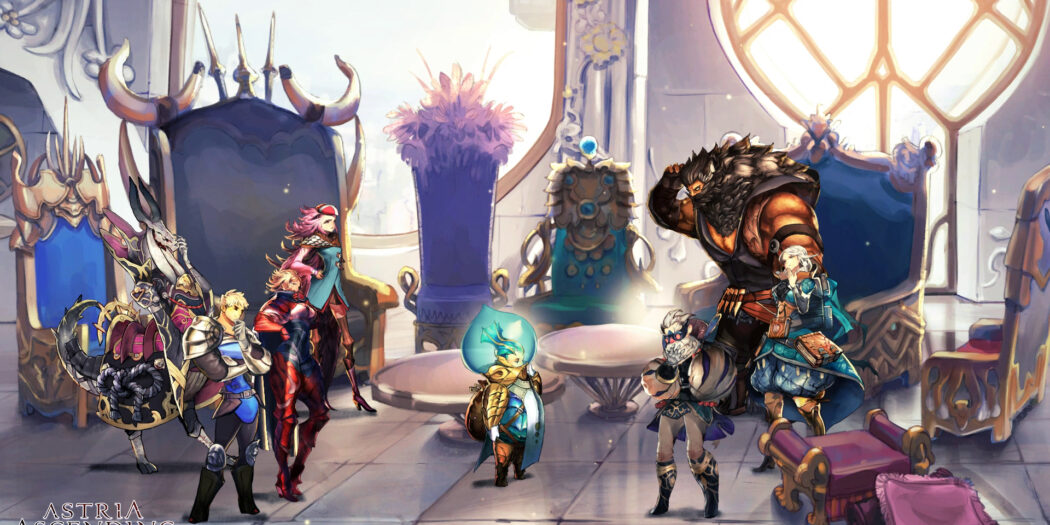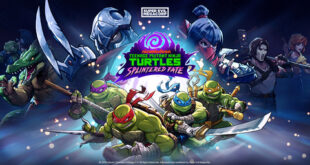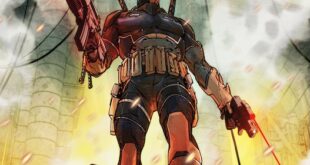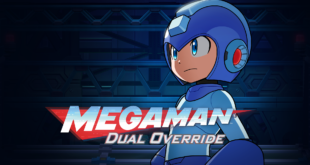Get stuck in with the beautiful Astria Ascending if you can handle debilitating battles and missed opportunities.
Astria Ascending is a stunning, hand-drawn, turn-taking RPG inspired by the classics— and written by them too. There’s some serious pedigree behind this project: Kazushige Nojima (FFVII Remake, FFX, FFII) worked on the narrative; Hitoshi Sakimoto (FFXII, Valkyria Chronicles) did the music; and Hideo Minaba (FFVI, IX, and XII) and Akihiko Yoshida (FFXII, Nier: Automata) led the art direction.
Those are some big names from some even bigger projects.
And for the most part, together with Artisan Studios, they’ve succeeded in crafting something special.
But even special isn’t without its frustrations.
Premise
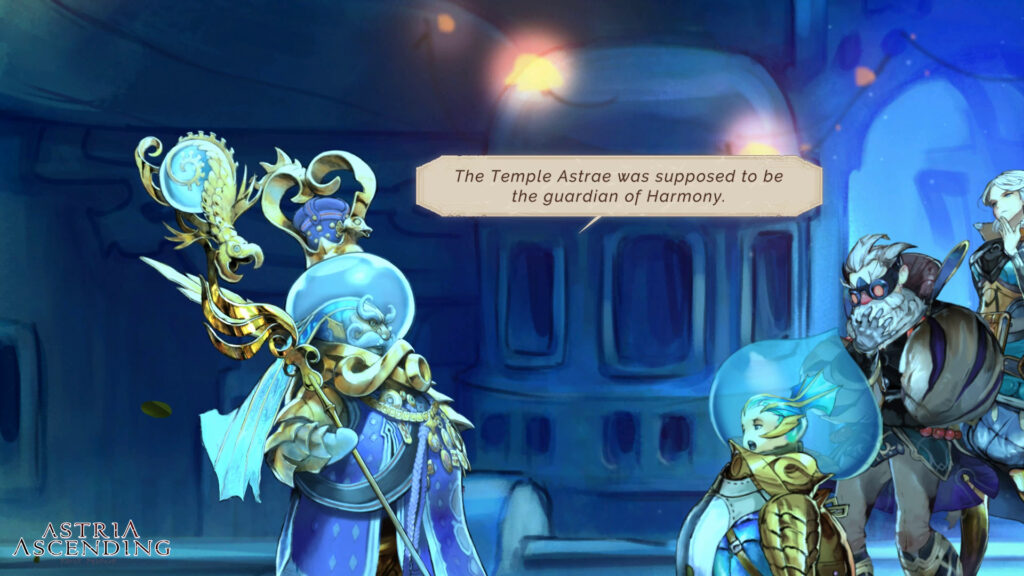
Astria Ascending is a full game. From corner to corner, it is filled to the brim with stunning art, fresh enemy designs, strategic boss fights, puzzle-filled dungeons, and even a complete, token-based mini-game. The entire journey is pulled along by the new: new classes, new music, new art, new distractions…indeed, the game never rests for the developer-suggested run-time of 25-35 hours (for the main story; it took me 37. Artisan Studios suggests completionists will be able to wring out double that. I’m inclined to agree).
Where other games stumble in the second half, whether simplifying dungeons to streamline the finish or stagnating without new gameplay hooks, Astria Ascending maintains a confident stride. Up until the last five hours, I was still unlocking subclasses, support classes, and abilities that transformed the ways I approached the combat.
As for the story, Astria Ascending features an intriguing hook: eight people are chosen to become demi-gods, given the power and responsibility to protect the world’s harmony at the sacrifice of their own lives. After three years, that’s it. They die. The narrative is at its best when it explores the characters’ impending doom, but it does so infrequently that it’s hard to remember just what it is the characters are giving up.
It’s that sense of connection that’s largely missing. To start, we’re dropped not at the beginning of these Demi-Gods’ careers, but in the last three months. The team of eight is already assembled. They’ve already made their peace with their circumstances. That sacrifice at the core of everything affects the plot, but rarely the hearts and minds of the characters. When hints of it poke through, such as when the youngest, Eko, decries the lack of respect he’s given—after all, he’s been with them for 2.75 years, hasn’t he, and he’s giving up just as much as them—Astria Ascending quickly moves along. Each character’s biggest moment comes in a flashback. Ultimately, none of them are given the time they deserve to truly stand out. For such a lengthy RPG, it’s a shame not to be invested in the characters that drive it.
Presentation
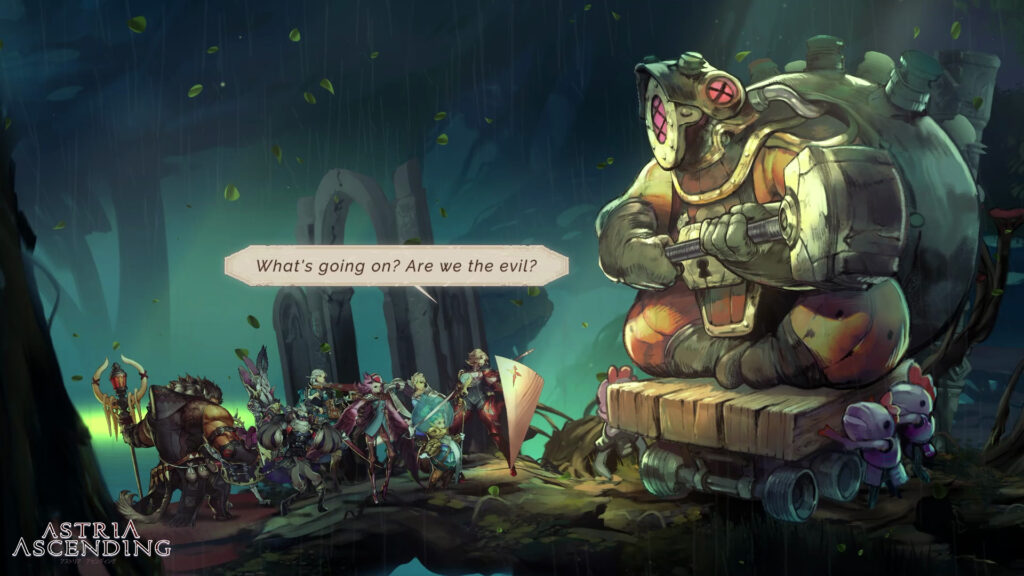
It’s a good thing the art and music do so much heavy lifting, then. Atria Ascending’s is a beautiful world. Each race is afforded a dazzling design, from the lizard-like Zeft to the endearing Migmies, and each locale and background is drawn in stunning detail. On the Playstation 5, the game is a veritable treat for the eyes.
And the ears. Hitoshi Sakimoto knocks it out of the park with a stream of stunning, sweeping musical pieces. From the title screen to the credits, each song sets the flavor and feel of the world magnificently. He is a master of epic, fantasy tunes that capture a true sense of place, and his distinct style is on full display.
The technical pieces that hold it together typically work very well, but some bugs persist even after the day-one patch update. Sometimes damage values don’t display; just after the patch, I completed a late-game boss fight and was required to do a full restart of the game when it wouldn’t leave the victory animation; more than once, I was unable to decline a match of the minigame, J-Ster, once I realized their difficulty was outside the realm of my deck’s capabilities. As in many JRPGs, you can hit an enemy with your sword to engage in combat with a higher chance for a preemptive strike. This animation sometimes doesn’t appear. Worse, sometimes I had to reload an area because the button wouldn’t do anything.
I got into the habit of saving often after an area didn’t load the visuals properly (my HUD was still there, as well as the music and the sound of me moving around, but everything else was black). It happened twice early, and not since (and definitely not since the patch), but it started a good habit.
A necessary one, because even standard battles can be a nightmare in Astria Ascending.
Gameplay
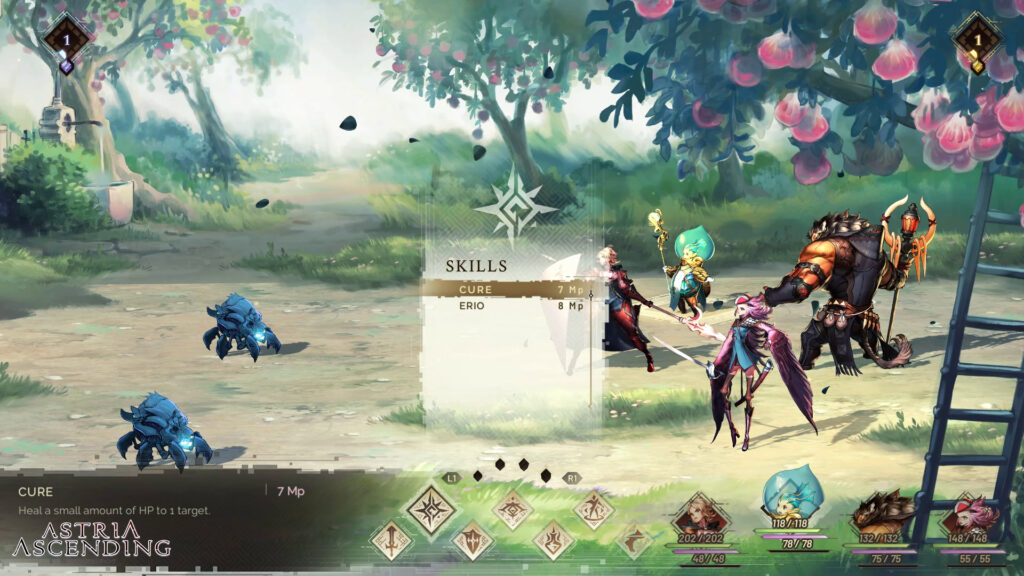
Astria Ascending’s battle system elevates it with a real sense of strategy. It features a Focus system that will be familiar to players of Shin Megami Tensei (SMT). Hit a target’s weakness and you’ll gain two focus crystals. Hit a target’s strengths, and you’ll lose one (or two). Any member of your party can spend that focus to increase their damage by 50%, up to a max of 200%.
The enemies can do it too, which makes combat a careful balance of defensive and offensive specialties.
In the early game, this gives every member of your party a chance to shine. Any party member can spend their turn to switch up one to four active combatants, letting you constantly adapt to the circumstances.
Early, the combat is much like classic JRPGs: simple, requiring just enough attention to get by. Health is returned automatically at the end of every battle, making them ideal for grinding. At first, you’ll need to figure out each unit’s individual weaknesses.
Having done this for plenty of SMT games, I quickly opted to turn on one of the game’s handy options: the ability to see whether the target will be weak, strong, immune, or otherwise unperturbed by my attack. While you can scan an enemy with some characters, that information is not accessible moment to moment. Forget what the scan told you, and you’ll have to scan it again. Having scanned a rat once doesn’t help you out with the next rat, even if it’s the identical enemy type.
This isn’t the only information you desperately need that isn’t readily available when you need it. I would have loved to know my own characters’ elemental affinities outside of the status or equipment menus, but when you’re swapping out party members during battle, there’s nothing to help. It can make it difficult to know if you’re sending someone to their death or genuinely bringing in a solution.
At least I had that handy option. It’s one of many provided. Battles have four difficulties (Very Easy, Easy, Normal, and Hard; I played on Normal). You can lower the amount of experience and SP (used on class skill trees) your characters earn who aren’t in combat or prevent yourself from earning gold, experience, items, etc. from battles at all. Even the exploration segments can be adjusted for painless going. You can make it so enemies don’t respawn so that you can focus on the puzzles at hand.
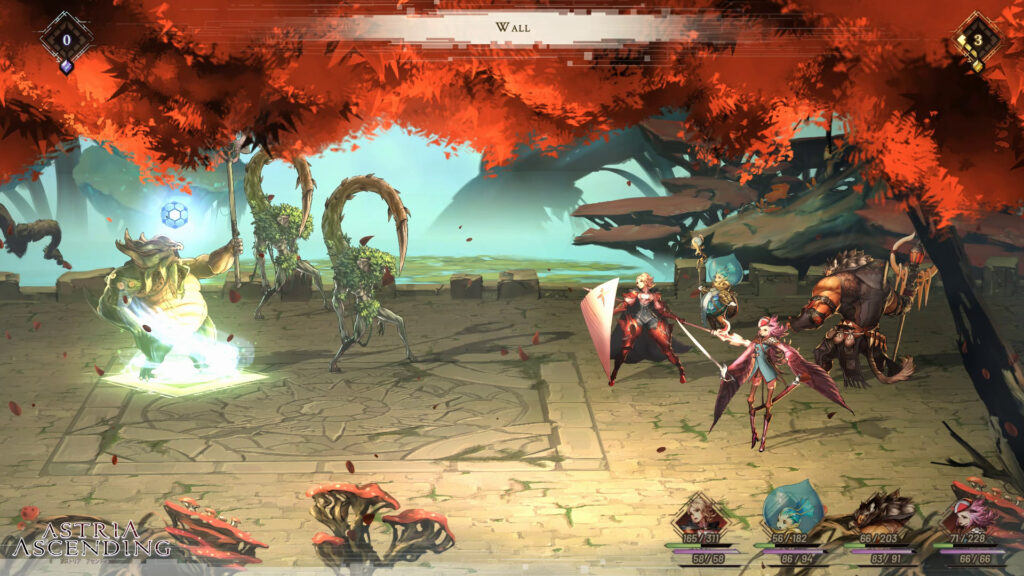
Standard enemy fights change drastically in the latter half, though. An enormous number of standard enemies resist or are immune to physical attacks, making those specialists nearly worthless. If they didn’t stand out in boss fights where your target is weak to physical strikes, they never would have seen any use. Only my most versatile elemental casters, supports, and defensive specialists could tango with most mobs. Unfortunately, this meant I stuck with the same team of four for most of the second half of the game.
More unfortunate is the staggering difficulty of these fights. Enemies by and large out-speed the party, even with heavy investment into agility, which led to more than one near-wipe before I could enter a command. Party members die, regularly. It seemed every turn I was reviving, healing, or otherwise coming back from the brink. Party-wide debuffs become abusive, from Unfocus preventing you from engaging with the game’s most necessary system to Berserk, which, in particularly misfortunate scenarios, can wipe your entire party. Accessories that make you impervious to the worst of them (including Mute) are available, but in short supply or at great expense. Of course, you can’t prepare for every possible debuff.
In boss fights, this difficulty is welcomed. It forced me to genuinely get the most out of every character, to consider their every action with great care so that I could survive the onslaught. Doing this for every fight in a lengthy, nearly-40 hour JRPG? It can be exhausting.
If you want every fight to be a question of survival, not a guarantee of success, then you’ll love the depth on offer. If you’d prefer to make your way through Astria Ascending’s beautiful dungeons without saving between every encounter, then I’d recommend dropping the difficulty. At least until your next boss fight.
(Boss fights can be exhausting too; many are multi-phase, with no clear visual indication or suggestion of when you’re reaching the end. Some have six or more. Without even a hint, it’s hard to know how to use your resources.)
I enjoyed the combat and the pain enough not to touch the difficulty, through to the end, but it did feel masochistic in many situations. I can only imagine how punishing the Hard mode must be. Ultimately, I think I left it where it was because the strategic fights truly rewarded my level paths. Each character earns a main class, sub class, and support class throughout the game, in addition to their starting class. Each presents its own tree with active skills, passive support skills, super Cosmic attacks, and stat boosts. It’s versatile enough you can build any character in almost any way you like. It would have been nice to be able to preview skill trees before committing to them or to be able to re-spec, but once you start combining classes, the allure and itch-scratching of RPG customization hits in full form.
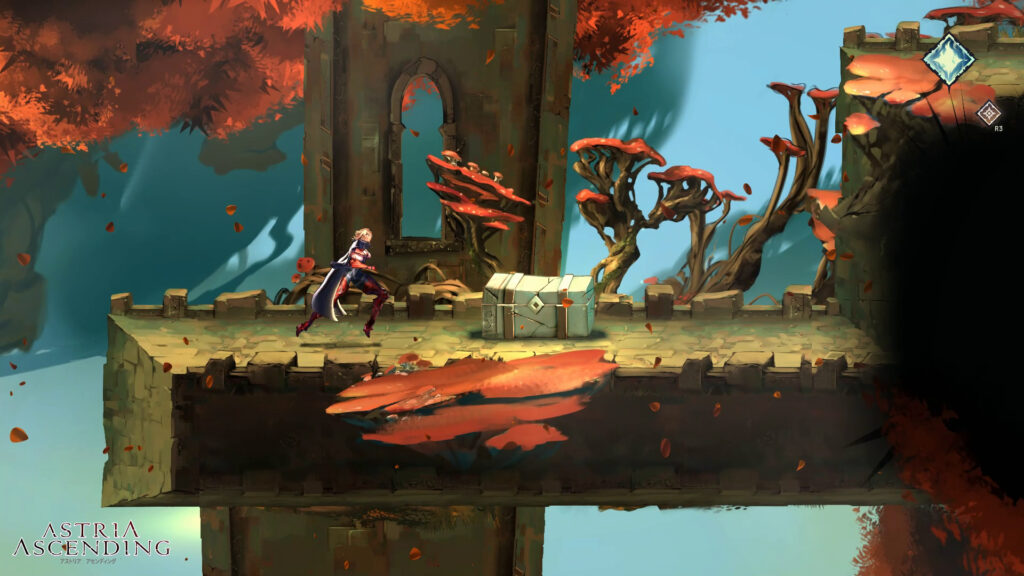
All those battles take place in the myriad of dungeons present in Astria Ascending. From the very start, these 2D, platforming-light, and maze-medium sections are filled with interesting puzzles. You’re equipped with a constantly evolving power ring that lets you engage with the puzzles in new ways. From pushing blocks with a wind shot to trading places with a statue, these abilities open up new paths in old areas. They’re thoughtfully introduced and can be used in creative ways to maneuver the world and make for enjoyable exploration that keeps the dungeons from growing stale.
The fast travel mechanic lets you instantly go back to town at any time to recoup your MP and then return to one of several, fairly-placed checkpoints. On Playstation 5, the load times between are so fast that it takes longer to save than it does to move between points. This helps alleviate some of the grind from dungeons and make the world and side quests more accessible.
While dungeon-diving and mob-fighting will take up most of your time, there are other distractions. From side-quests to monster hunts, the typical works well (though most side-quest rewards aren’t worth the effort). A shoot-em-up is necessary for progression, but not particularly engaging (or good).
Better is J-Ster, the complete token-based mini-game that has you and your opponent placing tiles on a seven-space hexagon. Place a higher-value token next to your opponent’s, and you’ll make it your color. Whoever has the most at the end wins.
J-Ster was fantastic. Pieces are collected by killing enemies, opening chests, or transforming mobs into tiles, and grow stronger as the game progresses. While the beginning will afford you some 1 power tokens, by the end you’ll be dropping 6s, 8s, and more. Each piece differs not only in attack value but also in its defensive capabilities. Each of their six sides is given a W (effectively -2), R (+2), diamond (+0), or N (nullify) that impacts their defensive power. Rotating these sides is necessary to prevent your piece from being taken. There’s a chess-like requirement to think several moves in advance, due to the size of the board and the few numbers of moves you can make in a match. Differing rule sets keep things interesting, as does your constantly growing set of tokens.
And there are matches of J-Ster available everywhere. Plentiful NPCs want to play, and there’s even a coliseum-style gauntlet of matches to run. It’s nice to have a mini-game impact your engagement in even classic combat as you search for better and better pieces, and even better to see those tokens rewarded as you climb the (single-player) ranks.
Final Thoughts
Astria Ascending is a game with an average plot, excellent (if often grueling) combat, and stellar art. Bugs never help, but they mostly keep out of the way. Your distance with Astria Ascending will greatly depend on how involved you like to be with even the common mobs, and how much you enjoy watching everything fall apart as quick enemies summon reinforcements, slaughter your party, and cripple them with overbearing debuffs. If you really don’t like the sound of that, but the art tickles your fancy, then the generous options available to customize your difficulty should help. Ultimately, I enjoyed my time with the game, but that recommendation can only come with the above caveats. And if you do pick it up, make sure not to miss out on J-Ster!
PS5 Review Copy provided by Dear Villagers for review.
Astria Ascending
Release Date: Sep 30, 2021
Platform: PS5, PS4, Xbox One, Xbox Series + Gamepass, PC Steam, PC Epic Games Store
Publisher: Dear Villagers
Developer: Artisan Studios
MSRP: $39.99
Astria Ascending
Premise - 70%
Gameplay - 80%
Presentation - 80%
77%
Good
Astria Ascending excels in combat, exploration, and art, but stumbles in pacing and the lack of a human connection to its vividly designed characters.
 BrutalGamer Bringing you Brutally Honest feedback from today's entertainment industry.
BrutalGamer Bringing you Brutally Honest feedback from today's entertainment industry.

